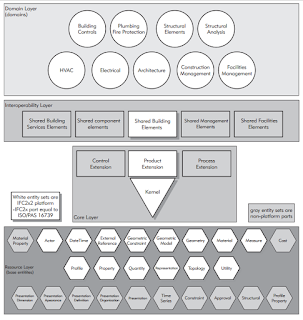Interoperability
represents the ability to exchange data between different applications, which
allows different fields of experts on separate applications to contribute to a project.
It is important to have interoperability when so many different types of people
(i.e. architectural, structural, MEP) are all trying to work on the same building.
In this post the focus will be on the progression and use of the Industry
Foundation Classes (IFC) data model. This is one of the major data models in
use today, and a main focus of chapter three (Interoperability).
First, a
little background on how IFC was started; in the mid-1980’s a technical
committee was initiated to determine a better way to exchange data between
systems. The organization was STEP (Standard for the Exchange of Product Model
Data), and their main product was the creation of the EXPRESS language. EXPRESS
is a language that has an object reference a computer language that represents
more than one physical object; it can represent ‘conceptual or abstracted
objects, materials, geometry, assemblies’, and more. [1] IFC uses ISO-STEP
technology (i.e. EXPRESS) to exchange consistent data representations of
building information among software applications. [1] The IFC is supported by BuildingSMART (previously International Alliance for Interoperability (IAI)),
which was created to support integrated application development.
Figure 1. System Architecture of IFC Subschemas
Figure 1
depicts a very clear representation of how the objects, or entities, are
configured in IFC. The top level represents the domain specific paths, and the
base entities (bottom layer) represent general building elements. The
base-entities can be specialized into sub-entities, due to IFC being
object-oriented and an extensible data model. The IFC covers basic geometry, including
extruded shapes, Bezier surfaces, and now Non-Uniform Rational B-spline (NURBS).
However, it cannot handle complex, editable parametric models currently (at the
time of this books publishing); however, translators are being written to
correct this. IFC data models can relate any sort of classification, such as: decomposes (between assemblies and their
parts), connects (topographical
relationships), and more. Property sets can be assigned to different material
behaviors (i.e. thermal materials and mechanical properties) and properties
relating to costs and time. One of the newest and most impressive property sets that can be applied is the reinforcement in concrete. This information is very useful when trying to analyze how the building will operate under different loads. However, properties dealing with tolerance and
uncertainty are still lacking.
IFC data
models are used and shared by using P-21 translators, both for export and
import. Currently, IFC Model Views are being developed to assist in the ease
and precision of exchanging information between different parts of a project
(i.e. the designer and structural engineer). The IFC data model is continuously
evolving, with a new release every two- years. The main downside to this model
is the massive level of expansion, and minimal support. However, due to the age
of this book there have most likely been a variety improvements over the years.
Currently, there is a variety of BIM software that has IFC export available, ArchiCAD,
Autodesk ADT, Tekla Structures, and more. [2]
Sources
[1] Eastman, Charles M. BIM Handbook: A Guide to
Building Information Modeling for Owners, Managers, Designers, Engineers, and
Contractors. Hoboken, N.J: Wiley, 2011. Web.
[2] "About BIM and the IFC." Solibri, 2016. Web.
15 Jan. 2016.
Comments
[1] http://ae-510-ay15-16.blogspot.com/2016/01/b2-group-b-cummings.html
Comment to Bryan Cummings,
Comments
[1] http://ae-510-ay15-16.blogspot.com/2016/01/b2-group-b-cummings.html
Comment to Bryan Cummings,
I agree that understanding the limitations on interoperability
systems is important within all types of software. Especially, in construction
where the designers, engineers, and contractors have to work so closely
together on the same model/system. As discussed in class, the construction
field is typically 10 years behind the aerospace field technologically, due to
funding disadvantages. This is also seen in interoperability, in the aerospace
field one computer system is used by all subsets in order to create a working
system. Thus, the technology is out there; the construction field just has to
put forth the time, effort, and funding to have the payoff of a fully
integrated system.
[2] http://ae-510-ay15-16.blogspot.com/2016/01/b2-group-b-alex-palma.html
[2] http://ae-510-ay15-16.blogspot.com/2016/01/b2-group-b-alex-palma.html
Comment to Alex Palma,
You focused on a different part of the chapter than I did;
however, I enjoyed the information you pointed out. I have never personally
used ProjectWise at either of my Co-op’s, but its ability to manage so many of
files at one time seems extremely useful. Nevertheless, interoperability is an
extremely important factor when it comes to file share systems. Hopefully
ProjectWise can evolve into a system that can allow multiple users to make
changes at the same time (possibly through a cloud-like server as you
mentioned), because that is what is necessary in the construction field today.
In the future, the same concept of multiple people working on a Google Drive document
could be incorporated in to a BIM system. Obviously, BIM systems are much more
complex, but that is what the technology is moving towards.
